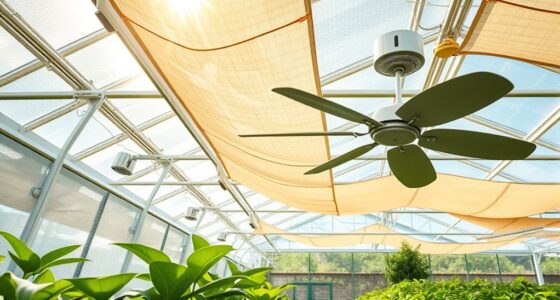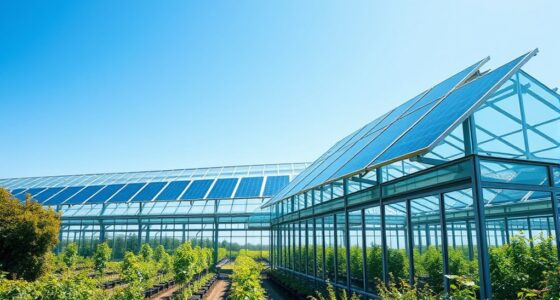AI-driven climate control systems act as the brain behind perfect crops by using advanced sensors and data analytics to monitor environmental conditions in real time. They accurately track factors like temperature, humidity, and soil moisture, then analyze this data to make smart adjustments automatically. This continuous learning process helps optimize growing environments, reduce resource waste, and boost yields. Keep exploring to discover how this innovative technology is transforming agriculture into a smart, efficient practice.
Key Takeaways
- AI integrates advanced sensors and data analytics to continuously monitor environmental conditions for optimal crop growth.
- Real-time data processing enables swift adjustments to climate parameters, maintaining ideal microclimates.
- Predictive models forecast future environmental changes, supporting proactive resource management and crop health.
- The system enhances sustainability by precisely targeting water, energy, and nutrients, reducing waste.
- Ongoing technological evolution refines AI’s accuracy and responsiveness, driving smarter, more efficient farming practices.

Have you ever wondered how artificial intelligence is transforming the way we manage climate control? It’s all about harnessing smart technology to create the perfect environment for crops, regardless of external conditions. At the heart of this innovation lies sensor improvement—a process that ensures your system gathers the most accurate, relevant data possible. When sensors are refined, they become more precise, reducing errors and providing real-time insights into temperature, humidity, soil moisture, and other critical factors. This precision allows your AI system to react swiftly, adjusting climate variables instantly to maintain ideal growing conditions. Instead of relying on outdated, manual measurements, you benefit from a continuous flow of high-quality data, which is the foundation for effective decision-making. Expert advice emphasizes that ongoing sensor calibration is essential for maintaining data accuracy over time.
AI climate control relies on refined sensors for real-time, precise data to optimize crop environments automatically.
Data analytics plays a pivotal role in turning raw sensor data into actionable intelligence. Once the sensors collect information, advanced analytics processes this data to identify patterns, trends, and anomalies. This isn’t just about numbers; it’s about understanding what those numbers mean for your crops. For example, analytics can reveal subtle shifts in soil moisture levels that signal when irrigation is needed, or detect temperature fluctuations that could stress plants. Using predictive models, your AI system can forecast future conditions based on historical data, helping you plan interventions proactively rather than reactively. This proactive approach minimizes resource waste—water, energy, fertilizers—by precisely targeting needs, which not only boosts crop yields but also reduces environmental impact.
By integrating sensor improvement with data analytics, your AI-driven climate control system becomes a highly adaptable, intelligent brain that continuously learns and improves. It’s like having a dedicated team of experts monitoring every aspect of your crop environment around the clock, but with much faster response times. You’re no longer limited by human capacity or delayed data; instead, you operate in a seamless cycle of sensing, analyzing, and adjusting. This dynamic feedback loop ensures that your crops stay within ideal growing conditions, even when external weather patterns shift unpredictably. It’s this synergy of technology that turns traditional farming into precision agriculture, elevating productivity and sustainability.
In essence, sensor improvement and data analytics are the backbone of AI-driven climate control. They empower you to create the perfect microclimate for your crops, no matter what’s happening outside. As these technologies evolve, they’ll continue to refine and enhance your ability to grow healthier, more abundant harvests while conserving essential resources. This is the future of farming—smart, efficient, and perfectly tuned to nature’s needs.
Frequently Asked Questions
How Does AI Adapt to Unexpected Weather Changes?
When unexpected weather changes occur, AI adapts by using sensor integration to monitor real-time conditions. It quickly analyzes data on temperature, humidity, and wind, then makes immediate adjustments to climate controls like watering and ventilation. This real-time response helps you maintain ideal crop conditions despite weather surprises. The AI’s ability to adapt swiftly ensures your crops stay healthy, maximizing yield and minimizing damage caused by unpredictable weather patterns.
What Are the Energy Costs of Ai-Driven Climate Systems?
You might wonder about the energy costs of AI-driven climate systems. These systems do have significant energy consumption, which can impact overall operational costs. However, they often improve cost efficiency by optimizing resource use and reducing waste. While initial setup and ongoing energy use are considerations, many systems balance these costs with increased crop yields and sustainability benefits, making them a smart investment for modern agriculture.
Can AI Predict Long-Term Climate Impacts on Agriculture?
Imagine having a crystal ball for your farm’s future—AI can do just that with climate modeling and crop yield forecasting. You can predict long-term impacts by analyzing patterns and data trends, helping you prepare for droughts or floods before they arrive. This proactive approach lets you make smarter decisions, safeguard your crops, and boost yields, ensuring your farm stays resilient in the face of unpredictable climate change.
How Secure Is the Data Collected by These AI Systems?
You’re probably wondering how secure the data collected by these AI systems is. Rest assured, organizations prioritize data privacy and implement robust cybersecurity measures to safeguard your information. They use encryption, regular security updates, and access controls to prevent breaches. While no system is completely foolproof, ongoing advancements in cybersecurity help ensure your data remains safe and private, giving you confidence in the AI technology supporting agriculture.
What Training Is Needed for Farmers to Operate AI Climate Controls?
Like learning to ride a bike, operating AI climate controls requires practice. You’ll need farmer education to understand the technology and how to adjust settings for ideal crop growth. Embracing technology adoption might feel overwhelming at first, but with proper training, you’ll gain confidence. Workshops, hands-on demonstrations, and ongoing support help make the shift smoother, ensuring you harness AI’s full potential to improve yields and sustainability on your farm.
Conclusion
With AI-driven climate control guiding your crops like a skilled conductor, you harness the power of technology to create the perfect harmony of temperature, humidity, and light. It’s as if you’re planting a symphony where every note is precisely tuned for growth. As this digital brain works silently behind the scenes, you’re empowered to nurture healthier, more abundant harvests, turning your farm into a thriving masterpiece of innovation and nature working hand in hand.









